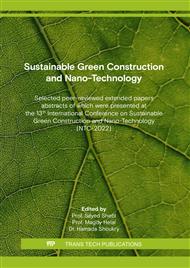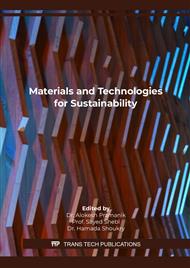[1]
M.S. Mahmoud and A.S. Mahmoud, Wastewater treatment using nano bimetallic iron/copper, adsorption isotherm, kinetic studies, and artificial intelligence neural networks, Emergent Materials, (2021), https://doi.org/10.1007/s42247-021-00253-y.
DOI: 10.1007/s42247-021-00253-y
Google Scholar
[2]
H.K. Alluri, S.R. Ronda, V.S. Settalluri, J.S. Bondili, V. Suryanarayana, P. Venkateshwar, Biosorption: An eco-friendly alternative for heavy metal Removal, African Journal of Biotechnology 6(25) (2007) 2924-2931.
DOI: 10.5897/ajb2007.000-2461
Google Scholar
[3]
Z. Song, C.J. Williams, R.G.J. Edyvean, Sedimentation of tannery wastewater, Water Res. 34 (2000) 2171-2176.
Google Scholar
[4]
A.S. Mahmoud, N.Y. Mohamed, M.K. Mostafa, and M.S. Mahmoud, Effective Chromium Adsorption From Aqueous Solutions and Tannery Wastewater Using Bimetallic Fe/Cu Nanoparticles: Response Surface Methodology and Artificial Neural Network, Air, Soil and Water Research, 14 (2021) 1–14, https://doi.org/10.1177/11786221211028162.
DOI: 10.1177/11786221211028162
Google Scholar
[5]
T.M. Abdel Ghany, M.S. Mahmoud, M.M. Alawlaqi, A.M. Reyad, A.M.H. Al-Rajhi, E.M. Abdkareem, Physicochemical Characterization of Agricultural Run-off and Groundwater Inoculated by Trichoderma asperellum and its Effect on Anti-oxidative Enzymes Production by Irrigated Trifolium alexandrinum L, BioResources 16(2) (2021) 3272-3284., https://doi.org/10.15376/biores.16.2.3272-3284.
DOI: 10.15376/biores.16.2.3272-3284
Google Scholar
[6]
S. Zhen-Hua, F. Shu-Jie, Z. Yu, T. Chao, G. Chen, N. Jian-Ping, Y. Bin, P. Feng, K. Mika, and M.S. Mahmoud, Industrial Scale-up of Fiber Recovery Technology from Mixed Office Waste Fine Screen Reject, BioResources 15(3) (2020) 6420-6430, https://doi.org/10.15376/biores.15.3.6420-6430.
DOI: 10.15376/biores.15.3.6420-6430
Google Scholar
[7]
S. Zhen-Hua, M.S. Mahmoud, F. Shu-Jie, Z. Yu, P. Feng, Combustion Properties of Mixed Black Liquor Solids from Linter and Reed Pulping, BioResources 14(2) (2019) 8278-8288, https://doi.org/10.15376/biores.14.4.8278-8288.
Google Scholar
[8]
A.M. AbouElmagd, M.S. Mahmoud, The synergetic effect of a fungal biofilm and an adsorbent media in a fluidized bed system on the wastewater treatment, Australian Journal of Basic and Applied Sciences 13(1) (2019) 86-95, https://doi.org/10.22587/ajbas.2019.13.1.11.
DOI: 10.22587/ajbas.2019.13.1.11
Google Scholar
[9]
A.S. Mahmoud, A. Ismail, M.K. Mostafa, M.S. Mahmoud, W. Ali, A.M. Shawky, Isotherm and kinetic studies for heptachlor removal from aqueous solution using Fe/Cu nanoparticles, artificial intelligence, and regression analysis, Separation Science and Technology (2019), ISSN: 0149-6395 (Print) 1520-5754 (Online), https://doi.org/10.1080/01496395.2019.1574832.
DOI: 10.1080/01496395.2019.1574832
Google Scholar
[10]
F. Shu-Jie, M.S. Mahmoud, W. Biao, S. Zhen-Hua, Z. Yu, Bioelectric Activity of Microbial Fuel Cell during Treatment of Old Corrugated Containerboard Discharges, BioResources 13(2) (2018) 3545-3553, https://doi.org/10.15376/biores.13.2.3545-3553.
DOI: 10.15376/biores.13.2.3545-3553
Google Scholar
[11]
M.S. Mahmoud, W. Biao, S. Zhen-Hua, F. Shu-Jie, Z. Yu, Parameters Influencing Power Generation in Eco-Friendly Microbial Fuel Cells, Paper and Biomaterials (PBM) 3(1) (2018) 10-16.
Google Scholar
[12]
R.A. SaryEl-deen, A.S. Mahmoud, M.S. Mahmoud, M.K. Mostafa, R.W. Peters, Adsorption and Kinetic Studies of using Entrapped Sewage Sludge Ash in the Removal of Chemical Oxygen Demand from Domestic Wastewater, with Artificial Intelligence Approach, 2017 Annual AIChE Meeting; Minneapolis, MN, October 29 - November 3, (2017).
Google Scholar
[13]
K. Tsekova, D. Todorova, S. Ganeva, Removal of heavy metals from industrial wastewater by free and immobilized cells of Aspergillus niger, Int. Biodeterioration & Biodegradation 64 (2010) 447-451.
DOI: 10.1016/j.ibiod.2010.05.003
Google Scholar
[14]
M.S. Mahmoud, M.K. Mostafa, S.A. Mohamed, N.A. Sobhy, M. Nasr, Bioremediation of red azo dye from aqueous solutions by Aspergillus niger strain isolated from textile wastewater, Journal of Environmental Chemical Engineering 5 (2017) 547–554.
DOI: 10.1016/j.jece.2016.12.030
Google Scholar
[15]
M.S. Mahmoud, S.A. Mohamed, Calcium alginate as an eco- friendly supporting material for Baker's yeast strain in chromium bioremediation, HBRC Journal 13(3) (2017) 245–254, https://doi.org/10.1016/j.hbrcj.2015.06.003.
DOI: 10.1016/j.hbrcj.2015.06.003
Google Scholar
[16]
M.S. Mahmoud, Decolorization of Certain Reactive Dye from Aqueous Solution using Baker's Yeast (Saccharomyces cerevisiae) Strain, HBRC Journal 12(1) (2016) 88–98, https://doi.org/10.1016/j.hbrcj.2014.07.005.
DOI: 10.1016/j.hbrcj.2014.07.005
Google Scholar
[17]
M.K. Mostafa, M.S. Mahmoud and R.W. Peters, Use of statistical analyses to assess water quality at the Damietta branch of the Nile river, Egypt, J. of Environment and Biotechnology Research 2(1) (2016) 16-26.
Google Scholar
[18]
Z. Abdeen, S.G Mohammad, M.S. Mahmoud, Adsorption of Mn (II) ion on polyvinyl alcohol/chitosan dry blending from aqueous solution, Environmental Nanotechnology, Monitoring & Management 3 (2015) 1–9.
DOI: 10.1016/j.enmm.2014.10.001
Google Scholar
[19]
M.S. Mahmoud, Banana Peels as an Eco-Sorbent for Manganese Ions, International Journal of Biological, Veterinary, Agricultural and Food Engineering 8(11) (2014) 1065-1071, eISSN:1307-6892.
Google Scholar
[20]
A.M AbouElmagd, M.S. Mahmoud, Tannery Wastewater Treatment Using Activated Sludge Process System (Lab Scale Modeling), International Journal of Engineering and Technical Research (IJETR) 2(5) (2014), ISSN: 2321-0869.
Google Scholar
[21]
M.S Mahmoud, A.M AbouElmagd, Characterization of alginate polymer and its application in copper removal from liquid wastes, Journal of American Science 9(11) (2013) 432- 439.
Google Scholar
[22]
M.M EL-Tayieb, M.M. El- Shafei, M.S. Mahmoud, The role of alginate as polymeric material in treatment of tannery wastewater, International Journal of Science and Technology 2(2) (2013) 218-224.
Google Scholar
[23]
A.S. Abdel-Razek, T.M. Abdel-Ghany, S.A. Mahmoud, H.H. El-Sheikh, M.S. Mahmoud, The use of free and immobilized Cunninghamella elegans for removing cobalt ions from aqueous waste solutions, World Journal of Microbiology and Biotechnology 25 (12) (2009) 2137.
DOI: 10.1007/s11274-009-0118-z
Google Scholar
[24]
A.S. Abdel-Razek, T.M. Abdel-Ghany, S.A. Mahmoud, H.H. El- Sheikh, M.S. Mahmoud, Treatment of Liquid Hazardous Wastes By Using The Fungus Cunninghamell aelegans, J. Rad. Res. Appl. Sci., 2(5) (2009) 890 –902.
Google Scholar
[25]
A.S. Abdel-Razek, S.A. Mahmoud, H.H. El-Sheikh, T.M. Abdel-Ghany, M.S. Mahmoud, Studies including tolerance, affinity and capacity of certain fungal species for some toxic elements in aqueous solution, Al-Azhar Bull. Sci. 19(2) (2008) 29-40.
DOI: 10.21608/absb.2008.10863
Google Scholar
[26]
APHA, Standard methods for the examination of water and wastewater, 23th edition. J. Am. Water Works Assoc. (AWWA), Washington, D.C, (2017).
Google Scholar
[27]
U.K. Garg, M.P. Kaur, V.K. Garg, D. Suda, Removal of hexavalent chromium from aqueous solution by agricultural waste biomass, J. Hazard. Mater. 140 (2007) 60–68.
DOI: 10.1016/j.jhazmat.2006.06.056
Google Scholar
[28]
M.Y. Arica, Y. Kacar, O. Genc, Entrapment of white-rot fungus Trametes versicolar in Ca-alginate beads: preparation and biosorption kinetic analysis for cadmium removal from an aqueous solution, Biores. Technol. 80 (2001) 121-129.
DOI: 10.1016/s0960-8524(01)00084-0
Google Scholar
[29]
Y. Sag, A. Yalcuk, T. Kutsal, Use of a mathematical model for prediction of the performance of the simultaneous biosorption of Cr (VI) and Fe (III) on Rhizopus arrhizus in a semi-batch reactor, Hydrometall. 59 (2000) 77-87.
DOI: 10.1016/s0304-386x(00)00143-2
Google Scholar
[30]
H.J. Benson, Microbiological Applications, WM.C. Brown Publisher (1985) 82 -88, Dubque, Lowa, USA.
Google Scholar
[31]
A. Cabuk, S. Ilhan, C. Filik, F. Caliskan, Pb2+ biosorption by pretreated fungal biomass, Turk. J. Biol. 29 (2005) 23-28.
Google Scholar
[32]
S.K. Chatterjee, I. Bhattacharjee, G. Chandra, Biosorption of heavy metals from industrial waste water by Geobacillus thermodenitrificans, J. of Hazardous Materials 175 (2010) 117-125.
DOI: 10.1016/j.jhazmat.2009.09.136
Google Scholar
[33]
G. Durai, M. Rajasimman, Biological Treatment of Tannery Wastewater - A Review, J. of Environmental Science and Technology 4(1) (2011) 1-17.
Google Scholar
[34]
M.Y. El-Naggar, S.A. El-Assar, A.Y. Youseff, N.A. El-Sersy, E.A. Beltagy, Extracellular β-mannanase production by the immobilization of the locally isolated Aspergillus niger, International Journal of Agriculture & Biology 8 (1) (2006) 57- 62.
Google Scholar
[35]
G.M. Gadd, M.M. Gharieb, L.M. Ramsay, J.A. Sayer, A.R. Whatley, C. White, Fungal processes for bioremediation of toxic metal and radionuclide pollution, J. Chem. Techno. Bjotechnol. 71(1999) 364-366.
DOI: 10.1002/(sici)1097-4660(199804)71:4<364::aid-jctb843>3.0.co;2-r
Google Scholar
[36]
A. Hammaini, A. Ballester, F. Gonzalez, M.L. Blazquez, J.A. Munoz, Activated sludge as biosorbent of heavy metals, Biohydrometall. and the environment toward the mining of the 21st century, Int. Biohydrometall. Sympos. IBS 99 (1999) 185-192.
DOI: 10.1016/s1572-4409(99)80107-2
Google Scholar
[37]
H. Lefebvre, N. Vasudevan, M. Torrijos, K. Thanasekaran, R. Maletta, Halophilic biological treatment of tannery soaks liquor in a sequencing batch reactor, Water Res. 39 (2005) 1471-1480.
DOI: 10.1016/j.watres.2004.12.038
Google Scholar
[38]
R. Muhammad, R. Nadeem, M.A. Hanif, T.M. Ansari, K.U. Rehman, Pb (II) biosorption from hazardous aqueous streams using Gossypium hirsutum (Cotton) waste biomass, J. of Hazardous Materials 161 (2009) 88-94.
DOI: 10.1016/j.jhazmat.2008.03.096
Google Scholar
[39]
Ahmed S. Mahmoud, MOSTAFA, M. K. & NASR, M. 2018c. Regression model, artificial intelligence, and cost estimation for phosphate adsorption using encapsulated nanoscale zero- valent iron. Separation Science and Technology, 1-14.
DOI: 10.1080/01496395.2018.1504799
Google Scholar
[40]
Mahmoud, M. S., Ahmed S. Mahmoud, Mohamed Ali El-Said, and Mohamed K. Mostafa. Comparison of aluminum and iron nanoparticles for chromium removal from aqueous solutions and tannery wastewater, empirical modeling and prediction., Emergent Materials (2021): 1-16.
DOI: 10.1007/s42247-021-00320-4
Google Scholar
[41]
Mahmoud, Ahmed S., et al. Nano zero-valent aluminum (nZVAl) preparation, characterization, and application for the removal of soluble organic matter with artificial intelligence, isotherm study, and kinetic analysis., Air, Soil and Water Research 12 (2019): 1178622119878707.
DOI: 10.1177/1178622119878707
Google Scholar
[42]
Ahmed S. Mahmoud, Rasha A. SaryEl-deen, and Mohamed K. Mostafa Artificial Intelligence for Organochlorine Pesticides Removal from Aqueous Solutions using Entrapped nZVI in Alginate Biopolymer,. Proc. 2017 Annual AIChE Meeting, Minneapolis, MN, (October 29 – November 3.
Google Scholar
[43]
Mohamed K. Mostafa, Ahmed S. Mahmoud, Rasha A. SaryEl-deen and Robert W. Peters Application of Entrapped Nano Zero Valent Iron into Cellulose Acetate Membrane for Domestic Wastewater Treatment,. Proc. 2017 Annual AIChE Meeting, Minneapolis, MN, (October 29 – November 3).
Google Scholar
[44]
Ahmed Karam, Mohamed K. Mostafa, Abdelsalam Elawwad, Khaled Zaher, Ahmed S. Mahmoud and Robert W. Peters Small-Pilot Plant for Tertiary Treatment of Domestic Wastewater Using Algal Photo-Bioreactor, with Artificial Intelligence, Proc. 2019 Annual AIChE Meeting.
Google Scholar



